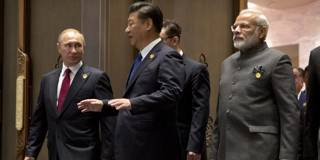Much has happened in the two decades since the BRICs (Brazil, Russia, India, and China) became a group to watch in the twenty-first century. While some of them have surpassed expectations, others have fallen short, as have the relevant global-governance institutions.
LONDON – This November will mark the 20th anniversary of the BRIC acronym that I coined to capture the economic potential of Brazil, Russia, India, and China. Many commentators will be revisiting the concept and assessing each country’s performance since 2001, so here are my own thoughts on the matter.
First, and contrary to repeated suggestion, the main point of my original November 2001 paper, “The World Needs Better Economic BRICs,” was neither to forecast endless growth for these economies, nor to promote some new marketing concept for investment funds. As anyone who read that paper will know, the central argument was that these economies’ probable growth in relative GDP would have important implications for global-governance arrangements.
With 2001 having been the third year since the introduction of the euro, I argued that large European countries – namely, France, Germany, and Italy – should be represented collectively, rather than individually, at the G7, the International Monetary Fund, and other organizations, thereby making room for the world’s rising economic powers. I then outlined four different scenarios of what the global economy might look like in 2010, three of which conjectured that the four BRICs’ share of global GDP would grow.

LONDON – This November will mark the 20th anniversary of the BRIC acronym that I coined to capture the economic potential of Brazil, Russia, India, and China. Many commentators will be revisiting the concept and assessing each country’s performance since 2001, so here are my own thoughts on the matter.
First, and contrary to repeated suggestion, the main point of my original November 2001 paper, “The World Needs Better Economic BRICs,” was neither to forecast endless growth for these economies, nor to promote some new marketing concept for investment funds. As anyone who read that paper will know, the central argument was that these economies’ probable growth in relative GDP would have important implications for global-governance arrangements.
With 2001 having been the third year since the introduction of the euro, I argued that large European countries – namely, France, Germany, and Italy – should be represented collectively, rather than individually, at the G7, the International Monetary Fund, and other organizations, thereby making room for the world’s rising economic powers. I then outlined four different scenarios of what the global economy might look like in 2010, three of which conjectured that the four BRICs’ share of global GDP would grow.